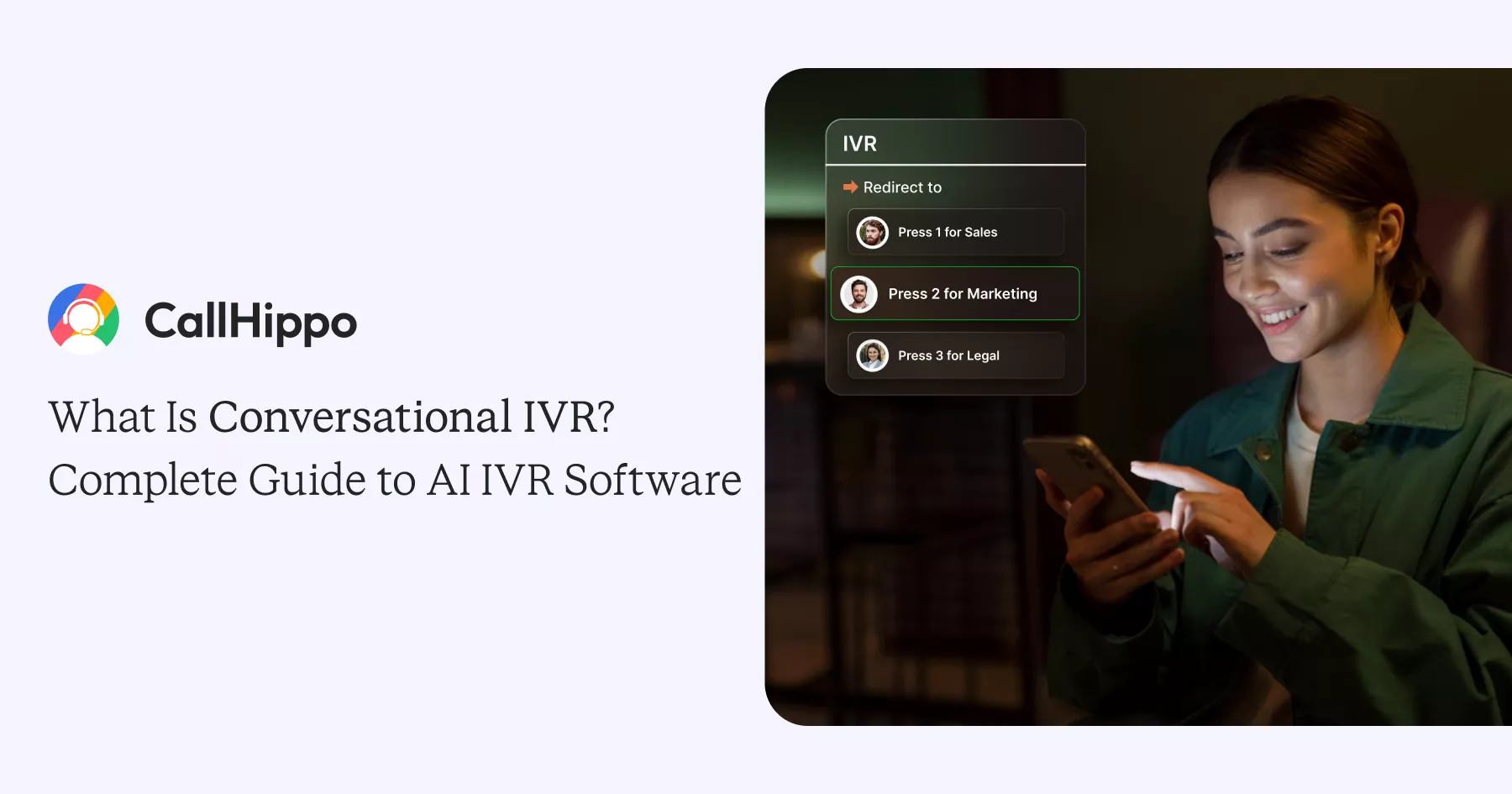

Updated : November 6, 2025
If you’re still using a menu-based phone system that says “press 1 for this, press 2 for that,” your callers may already be yawning, or worse, dialing your competitor.
Customer expectations have evolved. IBM reports that conversational AI interacting with external customers can reduce cost per contact by 23.5 % and increase annual revenue by around 4 %.
In other words, this isn’t just about sounding modern. It’s about real business outcomes. Here’s your complete guide to conversational IVR technology: what it is, why it matters, and how to implement it smartly.
What is Conversational IVR?
Conversational IVR (Interactive Voice Response) is an AI-driven, automated system that allows callers to speak naturally instead of navigating complex menus.
Unlike traditional interactive voice response systems, which rely on dual-tone multi-frequency (DTMF) inputs (like pressing 1 for sales), conversational IVR software works based on spoken requests using speech recognition and natural language understanding (NLU).
In short, when a customer says, “I want to check my account balance,” the system interprets customer intent and routes the call intelligently without forcing them through rigid call menus.
Why the Shift from Traditional to Conversational IVR Systems?
Traditional IVR gives repetitive prompts and limited choices, which often frustrates customers. Old IVR systems could not recognize free-form speech, which could leave users stuck in loops or disconnected from the appropriate department.
Companies are shifting to conversational-based artificial intelligence platforms for the following reasons:
- Encourages natural conversation while facilitating faster resolution time
- Provides reliable service across all digital mediums
- Creates better self-service experiences
- Offers intelligent call routing from customer data and intentions
In fact, 73% of customers expect that companies will comprehend their needs/expectations. Conversational AI IVR makes that possible through machine learning and natural language processing to create personalized experiences while still being contextual.
Build Smarter Conversations
with CallHippo’s AI-Powered IVR!
- 1Quick setup
- 2Smart Call Routing
- 324/7 support
- 4Easy CRM integration


Core Technologies Behind Conversational IVR
All conversational IVR systems use a combination of AI-based technologies to enable customers to interact with an IVR intelligently. These technologies analyze words for meaning and retain this information as a context for responding in real-time, leading to better experiences.
1. Automatic Speech Recognition (ASR)
Automatic Speech Recognition converts a customer’s questions into text that is usable by the system to understand the customer’s request. ASR engines today provide 90% or more accuracy, even in noisy environments, and enable the natural flow of customer interactions.
2. Natural Language Processing (NLP)
Natural Language Processing is the technology employed to enable the conversational IVR to understand human language contextually.
NLP provides the IVR system the ability to identify meanings and intent in the customer statement. For example, NLP allows the IVR to understand and interpret a sentence like “I need help with my bill.”
3. Dialogue Management
Dialogue Management is the technology used to control how the IVR responds and, most importantly, retains context within a conversation. This helps to keep a customer in a natural tone of conversation and provides context so the customer does not need to repeat themselves within a natural conversation.
4. Text-to-Speech (TTS)
Text-to-speech technology combines human-language responses into readable text, then converts the text to automated responses that sound like natural human speech. There are plenty of great TTS engines that refine a friendly voice while maintaining a consistent tone for delivering responses. It leads to building engagement and improving a company’s perception.
5. Integrating with Backend System
Conversational IVR quickly integrates with CRM systems, billing systems, and support systems to receive or update customer data. This allows for real-time interactions like valid balance checks or verifying the account without needing to engage a human agent.
Pro-Tip
Always review call transcripts and update ASR & NLP models to improve the specificity and personalization of responses based on real customers.
Conversational IVR vs Traditional IVR: A Comparison
Traditional IVR systems rely on rigid, menu-based interactions, while conversational IVR introduces natural, speech-driven communication. Here’s a quick comparison highlighting how open-source IVR transforms customer experiences.
| Aspect | Traditional IVR | Conversational IVR |
|---|---|---|
| Interaction Type | Button-based (DTMF) | Speech-based & natural language |
| Personalization | Minimal | Data-driven personalization |
| Response Flow | Static & linear | Dynamic & adaptive |
| Setup | Complex | Cloud-based & scalable |
| Customer Experience | Often frustrating | Engaging & intuitive |
| Support Model | Virtual agents required for complex customer queries | Self-service with escalation when needed |
Key Benefits of Conversational IVR
Conversational IVR is not simply an upgrade from your phone system. But it is smarter and more natural technology in its interaction with customers, and it decreases manual workload in your organization.
1. Enhanced Customer Experience
Conversational IVR enables callers to talk more naturally to get their answers quickly without going through complicated menu options. It makes every interaction easier, resulting in a better customer experience overall.
2. Operational Effectiveness and Cost Savings
Automating basic inquiries enables businesses to process calls more efficiently. This allows the agents to help with complicated inquiries and improve customer experience.
3. 24/7 Support & Scalability
Conversational IVR runs automatically and scales as the demand increases. This gives customers the assurance that they will get help in a timely manner.
4. Multilingual and Global Capabilities
Conversational IVR supports multilingual interactions, multilingual authorizations, and serves customers and agents together, preferably in their own language. This builds trust and accessibility in any region.
5. Data Insights & Personalization
Every interaction is a data insight touchpoint that provides a better response, with the ability to anticipate responses over time. Each interaction is even personalized over time, improving the accuracy of correct responses.
DID YOU KNOW?
- Review your call data and customer feedback to identify common and/or repetitive inquiries to help improve accuracy and flow in your IVR.
Uses of Conversation IVR
Conversational IVR is flexible to support most industries in order to have quick and accurate dialogue. This flexibility lowers wait times and enhances customer journeys, from healthcare to retail.
1. Telecoms
Telecoms use conversational IVR for account inquiries, upgrades, and giving access to the customer support line in order to improve service delivery.
2. Healthcare
Hospitals and Clinicians use conversational IVR for appointment scheduling, patient updates, and medication refills/renewals to improve communication with patients.
3. Banking and Finance
Banks use conversational IVR for secure account verification, immediate balance, and transaction information for delivering customer information on time.
4. E-commerce and Retail
Retailers use conversational IVR for checking order statuses, returns, product information, quick support, and lowering agent workload during times of peak demand.
When to (and When Not to) Use Conversational IVR
Conversational IVR for a contact center can bring great benefit to any customer service delivery organization. However, it is important to use it only when it can be optimized properly.
1. For Emotionally Sensitive or High-Stakes Conversations
When an emotion is involved with the sought-after information (e.g. medical emergencies, loss claims), you generally rely on the agent to be the best option.
2. When Your Call Volume Is Low or Irregular
When you have a very low volume of service calls, it may be more practical to not develop full automation AI capabilities within the organization and develop a traditional IVR setup instead.
3. When Your Audience Prefers Human Interaction
There are just consumers who would love to rely on human interaction. Therefore, simply providing a customer to speak to a human agent would be preferred to increase customer satisfaction.
Top Conversational IVR Providers
Here are some of the leading conversational IVR service providers known for their AI capabilities, seamless integrations, and ability to enhance customer interactions.
| Provider | Key Features | Ideal For |
|---|---|---|
| CallHippo | Cloud-based IVR, multi-level transfer, multilingual support, AI voice agent | SMBs and global enterprises |
| Nextiva | Unified communication platform, AI-powered routing | Mid to large businesses |
| RingCentral | Omnichannel engagement, CRM integrations | Scalable enterprise solutions |
| Twilio | Developer-friendly, programmable voice, robust APIs | Customizable applications |
| Sprinklr | AI-based sentiment analysis, unified CX platform | Large contact centers |
How to Implement Conversational IVR Successfully?
Developing a hosted IVR system involves more than simple technology implementation; it requires a focused plan that meets the needs of customers and organizations. Here’s how to get it right.
1. Define Objectives
First, you should explicitly define what you want your IVR system to accomplish. Is your goal to gain faster call resolution, less work for staff, or improve customer satisfaction? Having measurable objectives defined will allow you to ensure your design, flow, and other integrations are all aligned and contributing toward achieving your objectives.
2. Select the Right Platform
Select a conversational IVR platform that supports your organization’s size, call volume, and ability to integrate with other tools and software. Finding the right solution should also include recognizing related factors such as AI-driven call routing, multilingual support, and scalability to allow for future developments to the IVR system.
3. Define Conversational Flows
Flow out natural, conversational style dialogues that help users move through the call process easily. Here, you have to identify the common questions and sections of your flow, then anticipate variation in the way users ask throughout the call. Having a well-thought-out flow increases usability and reduces interruptions.
4. Connect Backend Systems and Data
Your IVR should be integrated easily with requests going to the correct tools, like your CRM, ticketing applications, or analytics tools. Integrating tools will allow a more dynamic response based on previous history or intent. Furthermore, it provides your team with data and valuable insights to personalize the call.
5. Test, Monitor, and Refine
Pilot the system in a testing period to find points in a limited environment, before making your changes public. Then, monitor call data, completion rates, and user feedback to adjust how you respond when there is less pressure. These data points will eventually make your IVR smarter..
Challenges and Considerations
Conversational IVR is a fantastic decision for any organization. However, there are common challenges that require consideration when rolling out any new customer interfacing technology.
1. Speech Recognition Accuracy
No matter how advanced a speech recognition system is, it will struggle with accents, background noise, and unclear pronunciation. Regularly tuning and training the model with real call data will help maintain the system’s accuracy.
2. Complex Intent and Flow Design
Users are going to express the same request in different ways. Designing your IVR flows to understand varied intents without frustrating the users is complex and tedious.
3. High Initial Investment
There is a huge investment need to build an AI-powered IVR that involves training data, integrations, and testing protocols. Over time, the manual and upfront costs will either balance or outweigh the initial setup cost.
4. ROI and Performance
Measuring ROI for conversational IVR goes beyond reducing call duration. The real value lies in improving customer satisfaction, boosting first-call resolution, and minimizing agent burnout.
Wrapping Up
Conversational IVR goes beyond just being another technological advance; it denotes a significant change in the way companies communicate with their customers. A carefully constructed conversational IVR effectively transforms the call experience from a barrier to a bridge within the customer communication.
The principal element in conversational IVR is to keep it human. Whether you are redesigning your IVR as a smaller organization or a contact center that handles a high volume of calls, conversational IVR will improve satisfaction, brand experience, and reduce expenses.
If you are interested in improving customer conversations and speed, this is the time to get moving!
FAQ
1. How long does it take to deploy a conversational IVR solution?
Most conversational IVR systems can be deployed within 4 to 12 weeks, depending on complexity and integrations. A simple setup is quick, while advanced solutions with CRM or analytics integration take longer.
2. Is conversational IVR secure and compliant with privacy laws?
Yes. Leading providers ensure compliance with data protection regulations like GDPR, HIPAA, and PCI-DSS. They use encryption, secure servers, and access controls to safeguard sensitive customer information.
3. Can conversational IVR detect customer emotions or sentiment?
Yes. Many modern IVR systems use AI-based sentiment analysis to pick up cues such as tone or stress in a caller’s voice. This helps route frustrated or urgent customers to human agents for a smoother experience.
Published : October 31, 2025

Shubham Nikam, Senior Product Marketing Specialist, brings 5 years of experience in VoIP demand generation and lead generation. He specializes in B2B SaaS, focusing on cloud telephony and CCaaS. Shubham excels in developing go-to-market strategies, optimizing product messaging, and leveraging AI tools to drive growth and customer acquisition.


Let’s Stay in Touch
Subscribe to our newsletter & never miss our latest news and promotions.
![]()
![]() +24K people have already subscribed
+24K people have already subscribed
Source



